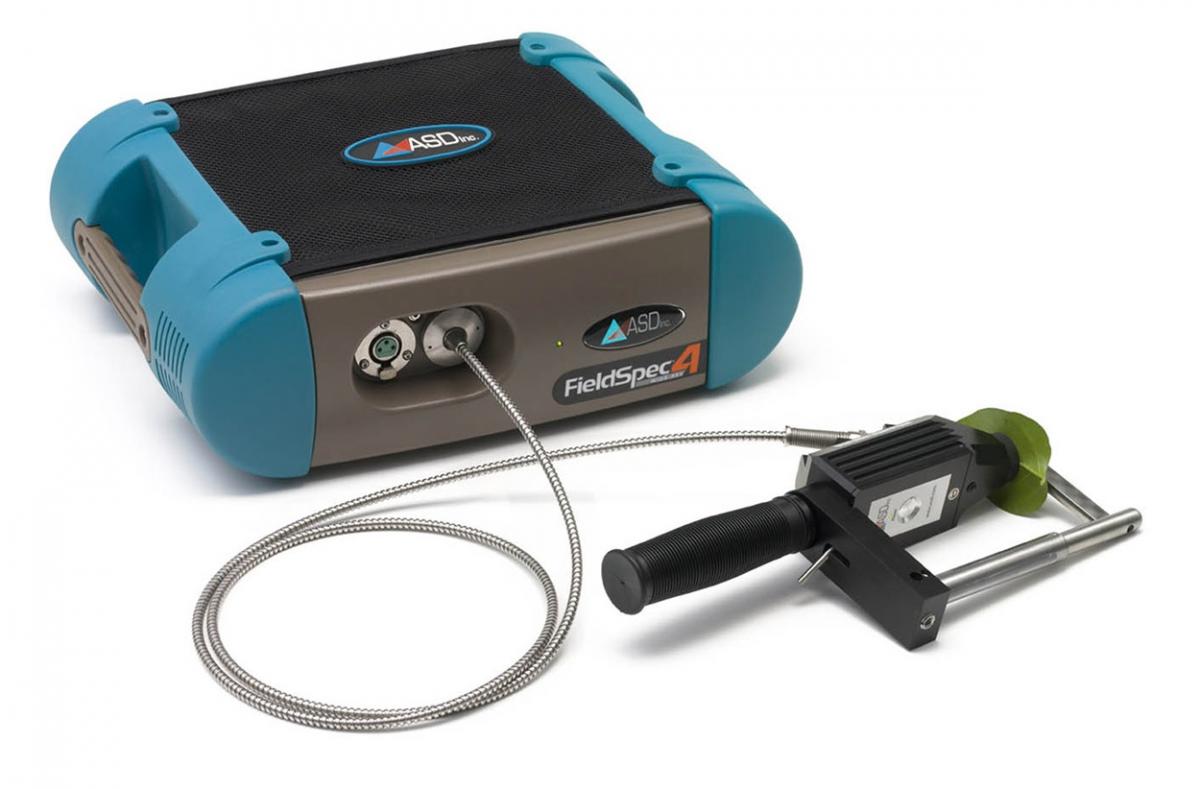Hyperspectral Spectroradiometer
Instrument Details:
Make : ASD Inc.
Model: FieldSpec 4 Hi-Res

Specifications:
|
Spectral Range |
350-2500 nm |
|
Spectral Resolution
|
3 nm @ 700 nm 8 nm @ 1400/2100 nm |
|
Spectral sampling (bandwidth) |
1.4 nm @ 350-1000 nm 1.1 nm @ 1001-2500 nm |
|
Scanning Time |
100 milliseconds |
|
Stray light specification |
VNIR 0.02%, SWIR 1 & 2 0.01% |
|
Wavelength reproducibility |
0.1 nm |
|
Wavelength accuracy |
0.5 nm |
|
Maximum radiance |
VNIR 2X Solar, SWIR 10X Solar |
|
Channels |
2151 |
|
Detectors
|
VNIR detector (350-1000 nm): 512 element silicon array SWIR 1 detector (1001-1800 nm): Graded Index InGaAs Photodiode, Two Stage TE Cooled SWIR 2 detector (1801-2500 nm): Graded Index InGaAs Photodiode, Two Stage TE Cooled |
|
Noise Equivalent Radiance
|
VNIR 1.0 X10-9 W/cm2/nm/sr @700 nm SWIR 1 1.4 X10-9 W/cm2/nm/sr @ 1400 nm SWIR 2 2.2 X10-9 W/cm2/nm/sr @ 2100 nm |
Working Principles:
The ASD FieldSpec 4 standard res. (FS4) is a transportable battery powered spectrometer. It is designed for measurements either in the course of field campaigns or in the laboratory. The spectral range of this highly resolving device covers wavelengths between 350 and 2500nm, the sampling rate is 0.2 seconds per spectrum. Three different detectors facilitate the recording of the spectra: a silicon-photodiode-array composed of 512 elements for the VNIR (350-1000nm) and thermoelectrically cooled InGaAs-photodiodes (Indium, Gallium, Arsenid) for each the SWIR1 (1000-1800nm) and the SWIR2 (1800-2500nm). With a spectral resolution varying from 3nm in the very short and 10nm in the farer wavelengths, the device records spectra based on the information of 2151 bands.
User Instructions:
Preparation (Handling the Device)-
- Always be careful when positioning, using and curling the fiber optic cable.
- Do not place the device onto the ports when the respective cables (power / LAN) are plugged in.
- The cable must not be bent nor be curled up with a diameter of less than 12cm.
- Make sure to safely curl up the fiber optic cable and place it beneath the net on top of the device.
- Avoid any kind of pressure onto the cable.
- A single disruption of even only one of the 57 glass fibers inside the cable causes degradation of the signal-to-noise-ratio up to 5%.
Safe Handling of the Device and its further Utilities
- The FS4 produces waste heat, so do not cover the ventilation slots on the bottom and the top of the device.
- A rechargeable battery will provide electrical power to the FS4 for approx. 4 hours. It is placed in another pocket of the backpack.
- The backpack’s rain cover is not suitable for use during continual rainfall à store the FS4 in a dry and cool place.
- There are two notebook-batteries. Each of them has an operating time of approx.1.5h, so this is the most common limiting time factor of measurements in the field.
- The device is to be switched on at least 20 minutes before any kind of measurements.
- Under no circumstances must the surface of the Spectralon Panel be touched or messed.
- SWIR modules are being chilled down to - 20°C, so the FS4 is not to be left in a hot car during warm up phase. When exposed to direct sun radiation the device will not be able to keep up the low temperature and therefore generate imprecise measurements or simply overheat and turn off.
- The FS4 is an expensive and precisely calibrated measurement device which is not insured by the state. Treat it carefully and responsibly at all time! Never leave it out of site, in the car or in a hotel room.
- Put the Spectralon Panel back into its isolated case whenever it is not in use.
Contact Us:
The Director, ICAR-NIASM
Email: director.niasm@icar.gov.in
Tel.: 02112 258000
Hyperspectral Spectroradiometer Charges:
|
S.No. |
Usage type |
Rate / per sample (Rs) for ICAR |
Rate / per sample (Rs) for other Govt. organisations |
Rate / per sample (Rs) for private research organization |
Rate / per sample (Rs) for Industries |
|
1. |
Laboratory per sample scan using contact probe |
25 |
50 |
125 |
250 |
|
2. |
Laboratory per sample scan using bare optic fibre in dark room |
100 |
200 |
500 |
1000 |
|
+ GST as applicable |
|||||
|
There should be minimum 5 samples |
|||||
